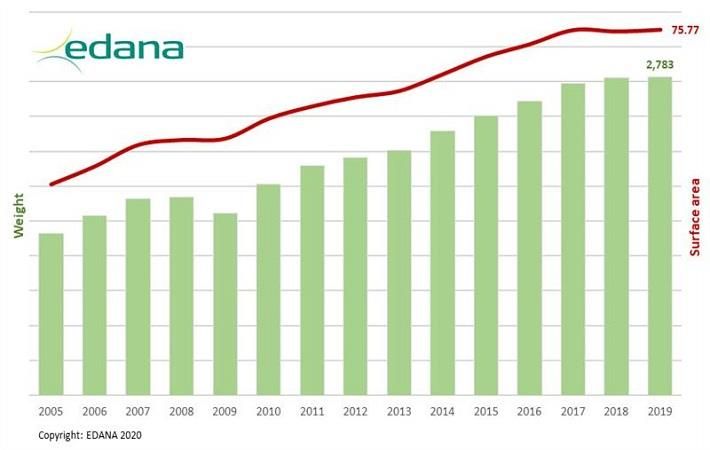According to figures compiled by European Disposables and Nonwovens Association (EDANA), production of nonwovens in Europe has reached 2,782,917 tonnes. This compares with 2,774,194 tonnes in 2018 when annual growth was 1.5 per cent. Despite these two low growth years, European production has recorded an average growth rate of 4.4 per cent over last decade.
According to figures compiled by European Disposables and Nonwovens Association (EDANA), production of nonwovens in Europe has reached 2,782,917 tonnes. This compares with 2,774,194 tonnes in 2018 when annual growth was 1.5 per cent. Despite these two low growth years, European production has recorded an average growth rate of 4.4 per cent over last decade.#
As a result of the recent economic conditions and, in particular, the downturn in several end-use sectors, figures for Greater Europe (Western, Central and Eastern Europe, Turkey, Belarus, Ukraine and Russia) show that the overall production of nonwovens has been flat in both weight (+0.3 per cent) and in surface area (+0.5 per cent) compared with 2018.
According to figures compiled by European Disposables and Nonwovens Association (EDANA), production of nonwovens in Europe has reached 2,782,917 tonnes. This compares with 2,774,194 tonnes in 2018 when annual growth was 1.5 per cent. Despite these two low growth years, European production has recorded an average growth rate of 4.4 per cent over last decade.#
“In terms of apparent growth rates, airlaid nonwovens has been in line with the long-term trend this year, but it is actually the hydro entanglement process that has recorded the highest growth rate, at slightly more than 5.5 per cent. However, other bonding processes within the drylaid technologies (thermally, air-through, chemically bonded and needled punched), as well as wetlaid nonwovens witnessed either flat or negative growth rates in 2019. Spunmelt nonwovens production, compared to its performance of 2018, recorded a growth of 0.6 per cent,” said Jacques Prigneaux, EDANA’s market analysis and economic affairs director.
According to figures compiled by European Disposables and Nonwovens Association (EDANA), production of nonwovens in Europe has reached 2,782,917 tonnes. This compares with 2,774,194 tonnes in 2018 when annual growth was 1.5 per cent. Despite these two low growth years, European production has recorded an average growth rate of 4.4 per cent over last decade.#
The main end-use for nonwovens remains the hygiene market with a 29 per cent share of deliveries, amounting to 792,620 tonnes, a growth of 1.5 per cent in 2019. The most significant increases in percentage in 2019 were in table linen (+12.3 per cent) and electronic materials (+6.8 per cent). In contrast, several important sectors in terms of volumes sold showed limited (and sometimes negative) growth rates: e.g. personal care wipes (+1.6 per cent), building/roofing (-0.3 per cent), civil engineering (-1.5 per cent) and automotive interiors (-2.5 per cent). Additionally, major declines were noticed in medical applications, garments, interlinings and wall covering.
According to figures compiled by European Disposables and Nonwovens Association (EDANA), production of nonwovens in Europe has reached 2,782,917 tonnes. This compares with 2,774,194 tonnes in 2018 when annual growth was 1.5 per cent. Despite these two low growth years, European production has recorded an average growth rate of 4.4 per cent over last decade.#
“Without the help of participating companies,” said Prigneaux, “these figures couldn’t be compiled, and we would like to thank them again for their efforts in sending their input to us, especially during the tumultuous period of the first quarter 2020.
According to figures compiled by European Disposables and Nonwovens Association (EDANA), production of nonwovens in Europe has reached 2,782,917 tonnes. This compares with 2,774,194 tonnes in 2018 when annual growth was 1.5 per cent. Despite these two low growth years, European production has recorded an average growth rate of 4.4 per cent over last decade.#
"Thanks to a convergence of efforts of the participating companies, to an improved ISO definition of nonwovens and to the continuous monitoring of EDANA staff, these statistics are more and more relevant for planning and benchmarking purposes within member companies."
According to figures compiled by European Disposables and Nonwovens Association (EDANA), production of nonwovens in Europe has reached 2,782,917 tonnes. This compares with 2,774,194 tonnes in 2018 when annual growth was 1.5 per cent. Despite these two low growth years, European production has recorded an average growth rate of 4.4 per cent over last decade.#
“As the world continues to discover the important role of nonwovens in protecting healthcare staff and patients through medical devices and personal protective equipment, such as surgical masks, respirators, gowns, drapes and coveralls during the Covid-19 pandemic, our ongoing commitment is to work with partner associations throughout the world, also to harmonise nonwoven production and sales statistics, and our positions on trade classification rules,” said Pierre Wiertz, general manager, EDANA. “This, together with the now improved ISO nonwovens definition, should give the whole industry the visibility it deserves.”
Fibre2Fashion News Desk (PC)


